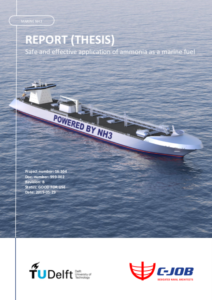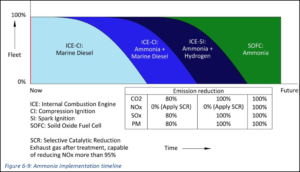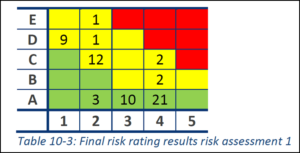Safe and Effective? New Study Evaluates Ammonia as a Marine Fuel
By Stephen H. Crolius on August 07, 2019

In mid-June the Dutch naval architecture firm C-Job released Safe and effective application of ammonia as a marine fuel, a thesis written by the firm’s Lead Naval Architect Niels de Vries for the Marine Technology Master of Science program at the Delft University of Technology in the Netherlands. While the thesis delivers an extensive assessment of ammonia’s potential effectiveness as a marine fuel, it breaks new ground in its consideration of ammonia’s safety in this context.
C-Job is a member of the Ammonia Energy Association, and we have previously reported on a number of the company’s projects, including its participation in an industry consortium pilot project to develop an ammonia tanker fueled by its own cargo.
Techno-economic assessment
The thesis is notable throughout for its rigor and thoroughness. It devotes five chapters to a techno-economic assessment of potential low-carbon fuels and propulsion systems for the maritime sector. Addressing ammonia’s characteristics as a fuel, de Vries concludes that “Ammonia has a significant higher volumetric energy and has far more practical storage conditions, considering pressure and temperature compared to liquid hydrogen. Furthermore, ammonia requires clearly less energy for renewable synthetic production than the carbon carriers. These are the main reasons to further investigate the potential of ammonia as a marine fuel.”

The technical discussion continues with a consideration of potential propulsion systems. De Vries concludes that solid oxide fuel cells may eventually prove to be the power plant of choice, but in the near term the ammonia-fueled two-cycle internal combustion engine (see MAN Energy Solutions: an ammonia engine for the maritime sector) is likely to win out. He presents an evolutionary approach through which the industry may eventually arrive at 100% ammonia power via discrete steps. And he speaks to the broad outlines of a scenario in which the economics of green ammonia could be competitive:
Studying the basic cost scenario, 850 euro per ton ammonia and 500 euro per ton low sulphur 0.5% HFO [heavy fuel oil], the ammonia powered option is clearly more expensive, about 3.2 times the expenses of the conventional option. Reflecting on future scenarios with 400 euro per ton ammonia, based on low electricity cost, it is in a similar range of 500 euro per ton HFO with 100 euro per ton CO2 taxation. In addition, this would be similar to 811 euro per ton HFO without CO2 taxation.
Niels de Vries, Safe and effective application of ammonia as a marine fuel, Delft University of Technology and C-Job Naval Architects, May 29, 2019
Risk identification and mitigation
De Vries devotes four chapters to identifying, classifying, and addressing the risks posed by ammonia as a marine fuel. The analysis is focused on a 54,000 tonne DWT (deadweight tonnage) tanker carrying ammonia in fully refrigerated storage tanks. It proceeds through four stages:
- Identification, where the risk is identified
- Analysis, where the risk is quantified
- Assessment, where the risk is prioritized/ranked
- Mitigation, where the risk is eliminated, reduced or prevented
Niels de Vries, Safe and effective application of ammonia as a marine fuel, Delft University of Technology and C-Job Naval Architects, May 29, 2019

For step 3, de Vries borrows a framework from the International Maritime Organization’s “International Code of Safety for Ships Using Gases or Other Low-Flashpoint Fuels” (IGF Code). At the framework’s core is a matrix, one axis of which is likelihood of a given “failure mode,” the other the failure mode’s severity. The framework simultaneously considers a failure mode’s risks to “persons on board, ship assets and environment.”
After working through his first three steps, De Vries produces a list of 61 failure modes. An example is “flooding and ammonia leakage in cargo hold” caused by a ship collision. This creates an initial risk ranking of E3: something that is “very unlikely” to happen but potentially resulting in multiple fatalities and catastrophic damage if it does.
In step four, de Vries applies “general engineering judgement” to generate potential mitigation measures. In the case of flooding and ammonia leakage in the cargo hold, the measures he suggests include pipe routing “with sufficient distance from shell;” addition of ammonia detection; addition of fuel flow detection; and addition of redundancy in the fuel supply line. In his “overall assessment” of this failure mode, de Vries mentions that routing the pipes well away from the hull will reduce likelihood of an ammonia release in the event of a collision; the ammonia presence and fuel flow detectors and pressure transmitters will prompt the crew to quickly discontinue ammonia supply if there is a rupture; and the fuel supply redundancy will ensure that the ship’s power plant can continue to operate even if the primary supply line has been shut off.
If applied, these mitigation measures can turn the E3 ranking into a D1 ranking: something whose odds of occurrence are “remote” (a probability of less than one event in a million ship-years) but that could cause “major damage” with “one death or multiple individuals with long-term health effects.” De Vries deems failure modes with rankings of D1 and others in the yellow zone of the matrix to be “tolerable,” as distinct from the “unacceptable” nature of failure modes with rankings in the red zone.


De Vries assigns each of the 61 failure modes to one of the risk matrix cells. The 28 that fall in the red zone clearly require mitigation. The 23 that fall in the yellow zone “are to be reviewed [to determine] if mitigation is sufficiently cost-effective.” After systematically working through the red and yellow failure modes, De Vries develops risk mitigation measures in 15 categories. “Applying these mitigations,” he says, “brings the risks . . . to a lower tolerable and acceptable level.”
De Vries notes that his is “the first known [public] risk analysis for an ammonia fuel system for a vessel.” He acknowledges limitations in his approach. “A risk analysis can be done with a qualitative or quantitative method,” he says. Because “no to little quantitative data [is] available to perform the analysis,” and because of the limitations of his own capacity, he had little choice but to use the qualitative method. As a result, he says, “it can be stated that this research is a valuable first step towards the application of ammonia as a marine fuel. Yet a lot of additional research is still required to explore its full potential and feasibility.”
De Vries will present a summary of his thesis on November 13, during the Ammonia Safety Session of the 2019 Ammonia Energy Conference in Orlando.